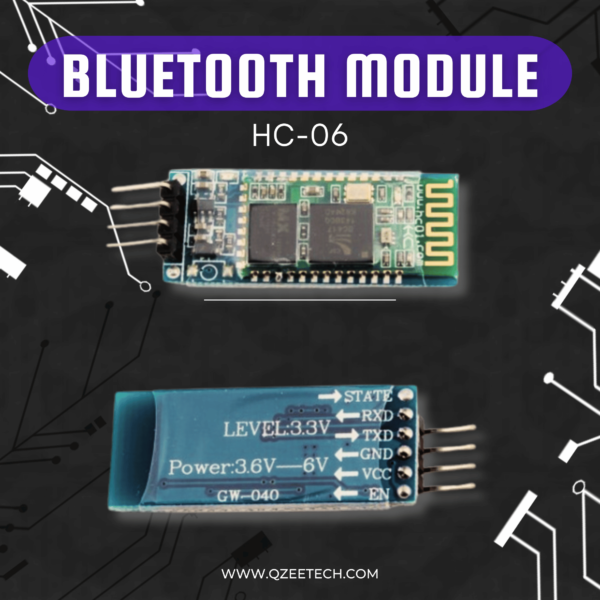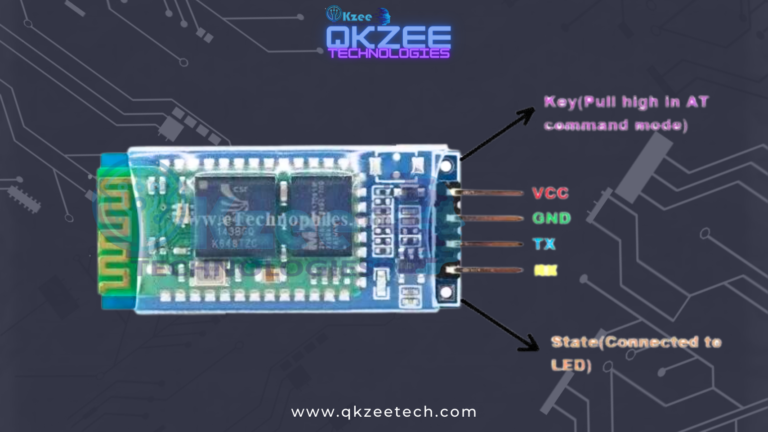HC-06 Bluetooth Module: A Simple Guide for Arduino Projects
Introduction
Are you looking to add wireless capabilities to your Arduino projects? The HC-06 Bluetooth module might be just what you need. This module is a popular choice for hobbyists and professionals alike, offering an easy way to enable Bluetooth communication in a variety of projects. From student projects to final year projects in engineering, the HC-06 is versatile and reliable. In this article, we’ll dive deep into the HC-06, covering its description, pin configuration, uses, features, and more. Ready to get started? Let’s go!
What is the HC-06 Bluetooth Module?
The HC-06 Bluetooth module is a simple, cost-effective solution for adding Bluetooth functionality to microcontroller projects, particularly with Arduino.The HC-06 Bluetooth module is a slave-only device designed for short-range wireless communication. It’s widely used due to its ease of integration, affordability, and reliable performance. This module facilitates serial communication between devices, making it perfect for projects where you want to wirelessly transfer data without complicated wiring.
Specifications and Features
Technical Specifications of HC-06
Voltage Requirements
The HC-06 operates at a voltage of 3.3V to 5V, making it compatible with a wide range of microcontrollers, including the popular Arduino boards
Communication Protocols
The module uses UART (Universal Asynchronous Receiver/Transmitter) protocol for communication. It supports baud rates from 1200 to 1382400, although the default baud rate is 9600.
Range and Data Rates
The HC-06 typically has a range of up to 10 meters in open space. Its data transfer rates can reach up to 2.1 Mbps, which is sufficient for most hobbyist applications.
Pin Configuration of the HC-06
Overview of the Pins
The HC-06 has a straightforward pin configuration with four main pins used for connection:
- VCC
- GND
- TXD
- RXD
- EN (optional)
Detailed Pin Description
VCC: This is the power supply pin, which can be connected to a 3.3V to 5V power source.
GND: This is the ground pin.
TXD: This pin is used to transmit data. It should be connected to the RX pin of the Arduino.
RXD: This pin receives data and should be connected to the TX pin of the Arduino.
EN: This is the enable pin, which can be used to enable or disable the module. It’s often left unconnected in basic applications.
How to Connect the HC-06 to an Arduino
Step-by-Step Guide
- Gather Components: You’ll need an HC-06 module, an Arduino board, jumper wires, and a breadboard.
- Connect Power: Attach the VCC pin of the HC-06 to the 3.3V or 5V pin on the Arduino, and the GND pin to the Arduino’s ground.
- Connect Data Pins: Connect the TXD pin of the HC-06 to the RX pin on the Arduino, and the RXD pin of the HC-06 to the TX pin on the Arduino.
- Power Up: Power up your Arduino and ensure the connections are secure.
Setting Up the HC-06 Module
AT Commands Overview
AT commands are used to configure the HC-06 module. These commands allow you to set various parameters like the module’s name, baud rate, and password.
How to Change the Name and Password
To change the name and password of your HC-06, you’ll need to enter AT command mode. Here’s how:
- Enter AT Command Mode: Open the Serial Monitor in the Arduino IDE and set the baud rate to 9600.
- Send Commands:
- To change the name:
AT+NAMEnewname - To change the password:
AT+PINnewpassword
- To change the name:
Configuring the Baud Rate
You can change the baud rate using the command AT+BAUDx, where x is a number corresponding to the desired baud rate (e.g., 4 for 9600).
Programming the Arduino for HC-06 Communication
Sample Code
#include <SoftwareSerial.h>
SoftwareSerial BTSerial(10, 11); // RX, TX
void setup() {
Serial.begin(9600);
BTSerial.begin(9600);
}
void loop() {
if (BTSerial.available()) {
Serial.write(BTSerial.read());
}
if (Serial.available()) {
BTSerial.write(Serial.read());
}
}
Explanation of the Code
This code sets up a software serial connection on pins 10 and 11 of the Arduino. It allows data to be transferred between the Arduino and the HC-06 module, making it possible to send and receive data wirelessly.
Common Uses of the HC-06 Bluetooth Module
Wireless Communication in Projects
The HC-06 is perfect for projects that require wireless communication, such as sending sensor data to a remote device.
Home Automation
Use the HC-06 to control lights, thermostats, and other home appliances from your smartphone or computer.
Remote Control Systems
Build remote control systems for robots, cars, or drones using the HC-06, allowing you to easily control them wirelessly.
Student Projects
The HC-06 is an excellent choice for student projects due to its simplicity and wide support, making it easy to implement in various educational projects.
Final Year Projects
The HC-06 can be a key component for engineering students in final-year projects, providing wireless communication capabilities that add sophistication and functionality.
Qkzee Technologies
Qkzee Technologies frequently uses the HC-06 module in their projects due to its reliability and cost-effectiveness, especially in developing smart solutions.
Engineering Projects
The HC-06 is widely used in engineering projects for its robust performance and ease of integration with Arduino and other microcontrollers.
Features of the HC-06 Module
Key Features
- Easy to use and integrate
- Supports various baud rates
- Low power consumption
- Reliable and stable connection
Advantages
The HC-06 is affordable, widely supported, and has ample documentation and community support, making it an ideal choice for both beginners and experienced developers.
HC-06 Bluetooth module Troubleshooting Common Issues
Connectivity Problems
Ensure that the module is powered correctly and that the connections are secure. Double-check the baud rates on both the HC-06 and the Arduino.
Communication Errors
Verify that the TX and RX pins are correctly connected and not swapped. Also, check for any interference from other electronic devices.
Module Not Responding
If the module is not responding to AT commands, ensure it is in AT command mode and that the baud rate is set correctly.
Tips for Optimizing HC-06 Performance
Improving Signal Strength
Position the module away from metal objects and other sources of interference to improve signal strength and reliability.
Minimizing Interference
Use shielded cables and avoid placing the module near other electronic devices that can cause interference.
Security Considerations for HC06 Bluetooth Module
Protecting Your Data
Always change the default password to prevent unauthorized access. Use secure passwords to enhance security.
Ensuring a Secure Connection
Consider implementing data transfer encryption protocols to ensure your communication remains secure.
Comparing HC-06 with Other Bluetooth Modules
HC-05 vs. HC-06
The HC-05 can function as both a master and a slave device, while the HC-06 is a slave-only module. This makes the HC-06 simpler but less flexible compared to the HC-05.
Other Alternatives
Other alternatives include the HM-10 for BLE (Bluetooth Low Energy) applications and the RN-42 for more advanced features.
Advanced Configurations and Hacks of HC06 Bluetooth Module
Extending Range
Use external antennas or repeaters to extend the range of your HC-06 module.
Customizing Firmware
For advanced users, customizing the firmware can unlock additional features and optimize performance for specific applications.
Conclusion
The HC-06 Bluetooth module is a versatile and reliable component for adding wireless communication to your Arduino projects. Its ease of use, affordability, and robust performance make it a favorite among hobbyists and professionals alike. Whether you’re working on home automation, remote control systems, or simple data transmission, the HC-06 is an excellent choice. Plus, if you’re in Lahore or shopping at Hall Road, you’ll find it to be one of Pakistan’s best solutions for Bluetooth communication.
What is the difference between HC-05 and HC-06?
The HC-05 can function as both a master and a slave device, while the HC-06 is a slave-only module. This makes the HC-06 simpler but less flexible compared to the HC-05.
Can HC-06 be used for audio transmission?
No, the HC-06 is designed for data communication and is not suitable for audio transmission.
How to reset the HC-06 module?
To reset the HC-06 module, you need to send the AT+RESET command in AT command mode.
What is the default baud rate of HC-06?
The default baud rate of the HC-06 is 9600.
Can multiple HC-06 modules communicate with each other?
No, since the HC-06 is a slave-only device, it cannot initiate communication with other HC-06 modules. It requires a master device like the HC-05 or a Bluetooth-enabled computer or smartphone.





